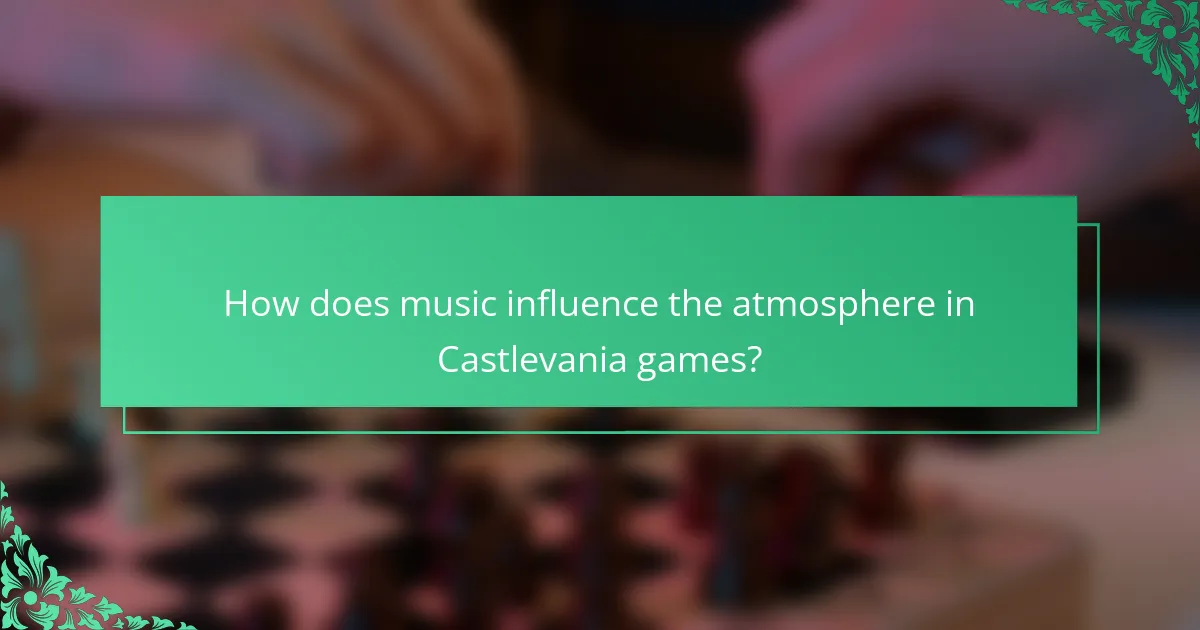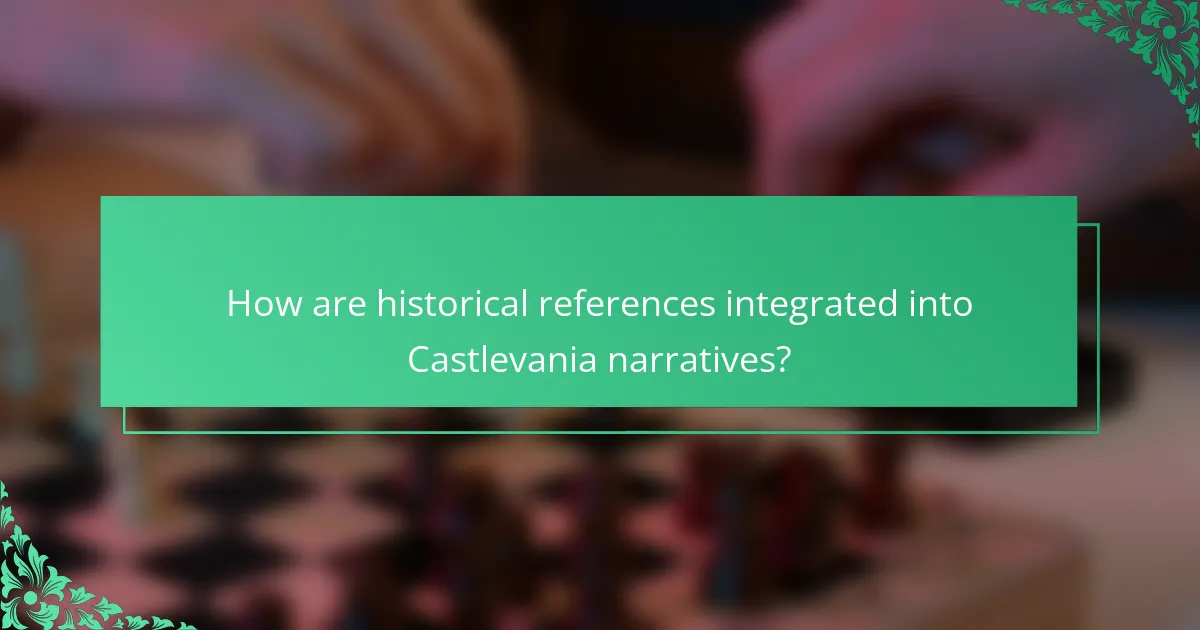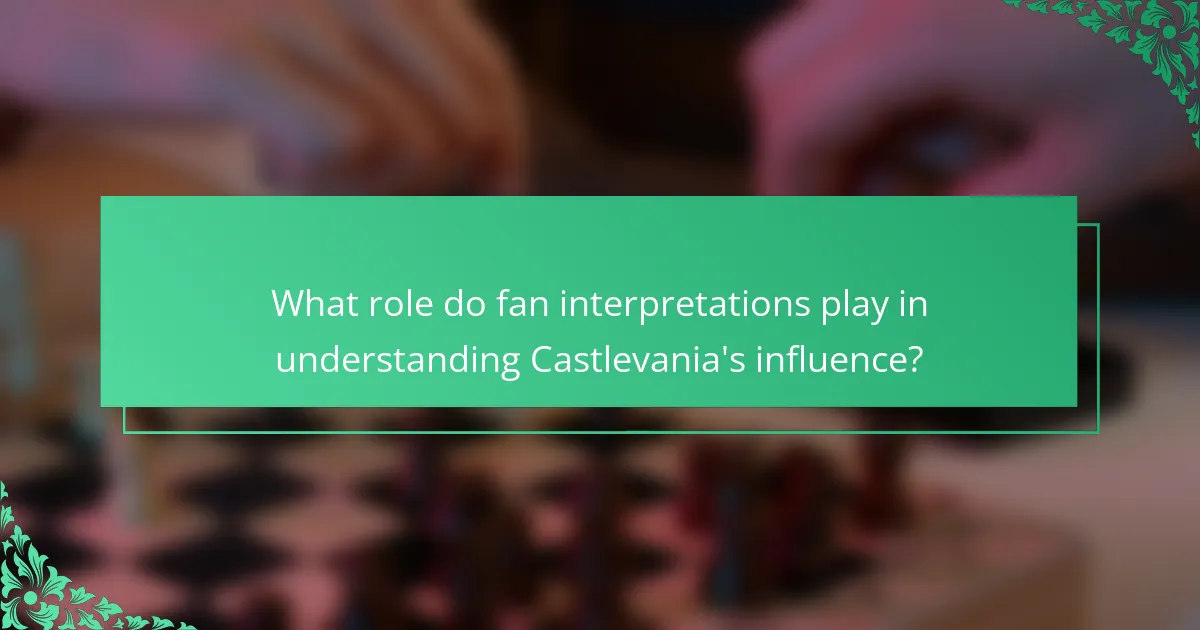The Castlevania series captivates players through its immersive music, diverse gameplay styles, and rich historical references. The orchestral scores enhance the gothic atmosphere, while gameplay mechanics vary from action-adventure to role-playing elements. Historical figures and events weave into the narrative, grounding the supernatural in recognizable contexts. Fan interpretations further enrich the understanding of Castlevania’s cultural impact and legacy in gaming.

How does music influence the atmosphere in Castlevania games?
Music significantly enhances the atmosphere in Castlevania games by creating tension and immersion. The series features orchestral scores that reflect its gothic themes, deepening player engagement. For example, the haunting melodies evoke a sense of dread, while dynamic compositions adapt to gameplay moments, such as boss encounters. This interplay between music and gameplay styles reinforces the historical references embedded in the narrative, enriching the overall experience. The unique attribute of Castlevania’s music is its ability to evoke nostalgia while simultaneously pushing the boundaries of video game soundtracks.
Which composers have shaped the iconic soundtracks?
The composers who have significantly shaped the iconic soundtracks of Castlevania include Konami Kukeiha Club, Michiru Yamane, and Yasunori Mitsuda. Their contributions blend orchestral elements with gothic themes, enhancing the game’s atmosphere.
Konami Kukeiha Club, the original sound team, established the series’ early musical identity. Michiru Yamane introduced a diverse range of styles, incorporating classical, rock, and electronic influences, particularly in titles like Castlevania: Symphony of the Night. Yasunori Mitsuda, known for his work on Chrono Trigger, contributed to the franchise’s later entries, further enriching its soundscape.
These composers have created memorable melodies that resonate with players, showcasing the unique attributes of the series’ music across various gameplay styles and historical references.
What are the key musical genres represented in the series?
The key musical genres represented in the series include orchestral, rock, and electronic music. Orchestral elements enhance the dramatic atmosphere, while rock influences provide energy during gameplay. Electronic music contributes to the modern soundscapes, creating a unique audio experience. Each genre contributes to the overall narrative and emotional depth of Castlevania.
How does music enhance gameplay experience and player immersion?
Music significantly enhances gameplay experience and player immersion in Castlevania through atmospheric soundscapes and thematic compositions. The game’s music creates emotional depth, guiding players through its gothic environments. Iconic tracks like “Vampire Killer” intensify action, while haunting melodies evoke a sense of dread. Historical references in the score connect players to the game’s lore, enriching their journey. This integration of music not only supports gameplay mechanics but also fosters a deeper emotional connection to the narrative and characters.

What gameplay styles are featured across the Castlevania series?
The Castlevania series features diverse gameplay styles, including action-adventure, platforming, and role-playing elements. Each installment showcases unique mechanics that enhance player engagement.
The action-adventure style is prominent in titles like “Castlevania: Symphony of the Night,” which integrates exploration and combat. Platforming elements are evident in classic entries, requiring precise jumps and timing.
Role-playing features, such as character progression and inventory management, appear in several games, adding depth to the experience.
Overall, the series combines these styles, creating a rich tapestry of gameplay that appeals to various player preferences.
How do classic and modern gameplay mechanics differ?
Classic gameplay mechanics in Castlevania emphasize exploration and strategic combat, while modern mechanics focus on narrative integration and fluid gameplay. Classic titles often feature limited save points and linear level designs, whereas modern iterations incorporate autosave features and open-world elements. The evolution reflects a shift from challenge and mastery to accessibility and storytelling. Classic games relied heavily on pixel art and chiptune music, while modern games utilize advanced graphics and orchestral soundtracks, enhancing the overall atmosphere and immersion.
Which gameplay elements contribute to the series’ unique identity?
The unique identity of Castlevania is shaped by its atmospheric music, diverse gameplay styles, and rich historical references. The series features orchestral soundtracks that enhance the gothic ambiance, creating an immersive experience. Gameplay varies from action-platforming to RPG elements, allowing for different player strategies. Historical references, including folklore and mythology, add depth to the narrative and character design, enriching the overall storytelling. These elements collectively contribute to Castlevania’s distinctive appeal in the gaming landscape.
What innovations have been introduced in recent titles?
Recent titles in the Castlevania series have introduced innovative gameplay mechanics, enhanced musical scores, and deeper historical references. The integration of orchestral arrangements has enriched the audio experience, while gameplay has evolved to include new styles, such as RPG elements and cooperative play. Historical references have become more nuanced, providing players with a richer narrative context. These innovations collectively enhance player engagement and immersion in the Castlevania universe.

How are historical references integrated into Castlevania narratives?
Historical references in Castlevania narratives enrich the storyline and enhance player immersion. The series incorporates real historical figures, events, and folklore, blending them with fictional elements. For instance, characters like Dracula draw from various cultural myths, while settings reflect Gothic architecture from different eras. This integration creates a unique atmosphere that resonates with both history enthusiasts and gamers. The use of historical references serves to ground the supernatural elements in a recognizable context, enhancing the overall narrative depth.
Which real-world figures and events inspire character design and storylines?
Real-world figures and events significantly influence character design and storylines in Castlevania. Historical references to figures like Vlad the Impaler shape character identities, while folklore contributes to narrative depth. The series also draws inspiration from gothic literature and horror films, enhancing its atmosphere and gameplay styles. The fusion of these elements creates a rich tapestry that resonates with players, intertwining history and fantasy seamlessly.
How does the series reflect cultural mythology and folklore?
The series reflects cultural mythology and folklore through its rich storytelling and character design. Castlevania incorporates elements from various mythologies, such as Dracula from Eastern European legends and various creatures from folklore. The gameplay intertwines these narratives, creating a unique experience that resonates with themes of good versus evil and the struggle against darkness. Each character embodies traits from their mythological origins, enriching the overall narrative and engaging players in a culturally immersive experience.
What significance do historical settings hold in gameplay and storytelling?
Historical settings significantly enhance gameplay and storytelling in Castlevania by creating immersive environments and enriching narratives. The series draws on gothic architecture and folklore, establishing a captivating atmosphere. This context allows players to engage with the lore deeply, as they encounter familiar historical figures and mythological elements. The integration of music influenced by classical compositions further amplifies the emotional experience, aligning with the tension and drama of the gameplay. As a result, players not only navigate challenges but also explore a richly woven tapestry of history and culture that adds depth to their adventure.

What role do fan interpretations play in understanding Castlevania’s influence?
Fan interpretations significantly enhance understanding of Castlevania’s influence by revealing diverse perspectives on its music, gameplay styles, and historical references. These interpretations often highlight how the series merges gothic themes with innovative mechanics, fostering a rich dialogue among fans. For instance, fans often discuss how the music integrates classical influences, which deepens appreciation for its cultural impact. Additionally, gameplay styles inspired by Castlevania have influenced numerous titles, showcasing its legacy in the gaming industry. Ultimately, fan interpretations serve as a lens through which the broader significance of Castlevania can be explored and appreciated.
How do community-created content and mods enhance the gaming experience?
Community-created content and mods significantly enhance the gaming experience by adding new dimensions to gameplay and storytelling. In “Castlevania,” mods can introduce unique gameplay styles, such as altered mechanics or character abilities, enriching player engagement.
Additionally, fan-made music tracks can reinterpret the game’s iconic scores, providing fresh auditory experiences that resonate with nostalgic elements. Historical references embedded in mods can deepen the narrative, connecting players to the rich lore of the franchise.
These contributions foster a sense of community and creativity, allowing players to share their interpretations and innovations, ultimately expanding the universe of “Castlevania” beyond its original confines.
What are the most notable fan theories surrounding the series?
Numerous fan theories surround “Castlevania,” exploring its music influence, gameplay styles, and historical references. One notable theory suggests that the game’s soundtrack is inspired by classical composers, enhancing the gothic atmosphere. Another theory posits that gameplay mechanics symbolize the struggle between good and evil, reflecting historical conflicts in vampire lore. Some fans speculate that character designs draw from historical figures, adding depth to the narrative. These theories enrich the understanding of the series, encouraging deeper engagement with its themes and aesthetics.
How does fan art contribute to the legacy of Castlevania?
Fan art significantly enhances the legacy of Castlevania by fostering community engagement and creativity. It allows fans to reinterpret characters and narratives, enriching the franchise’s cultural impact. Unique artistic styles reflect diverse interpretations, while fan creations often inspire official content, demonstrating the reciprocal relationship between creators and fans. This ongoing dialogue helps maintain the series’ relevance across generations, ensuring its place in gaming history.
What best practices can players follow to fully appreciate the Castlevania experience?
To fully appreciate the Castlevania experience, players should immerse themselves in its music, gameplay styles, and historical references. Engaging with the soundtrack enhances emotional connection, while exploring diverse gameplay mechanics reveals the series’ evolution. Familiarity with the historical context enriches the narrative experience, making each installment more meaningful.


